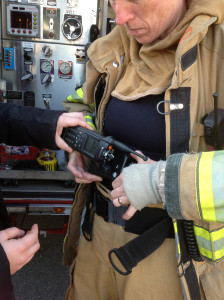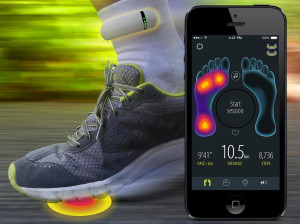Athletes and their trainers gather biometric data from the growing number of textile products with interactive technology.

Marceau so believes this that he undertook a long-term project to lead the charge. In 2008, he co-founded OMsignal, a Montreal-based company that in May of this year began taking orders for biometric shirts for men that monitor activity, physiological stress and fitness levels. A women’s collection is expected to be released by year’s end.
“Our products are well suited for the fitness market, but the possibilities are endless,” Marceau says. “Our team is on a mission to bring personal wellness into our daily lives.” OMsignal may be well on its way to doing so after a venture capital funding infusion of $10 million in late June.
Another Montreal-based company with biometric shirts that tracks heart, respiratory and activity data launched sales in fall 2013. “We’ve been working on wearable health technologies since 2006,” says Hexoskin (Carré Technologies Inc.) co-founder and CEO Pierre-Alexandre Fournier. “Up to 2009, we had a traditional approach in our wearable-sensor development; it looked more like a device you would see in a hospital. In 2009, we decided to adopt a form that fits into people’s lives.”
Hexoskin now targets “active consumers” and fitness trainers. The company plans to distribute its products through retail locations and adapt them to specific needs in international markets. Meanwhile, its garments are sold exclusively through the company’s website.
Heapsylon of Redmond, Wash., has developed a T-shirt, sports bra and socks with a range of smart textiles. Made in Italy, Sensoria® garments gather heart rate, force and pressure data. The T-shirt and sports bra, released in March, are available only on the company’s website. Vivobarefoot is distributing the socks in 400 stores worldwide.
“Sensoria products can bring benefits to all levels of runners and other athletes by providing real-time feedback regarding the quality of the workout,” CEO Davide Vigano says. “Trainers will be able to use our mobile app, dashboard and cloud-based software to remotely access their clients’ data and effectively provide a superior service without the need to be present.”
Welcome to the machine

Once the realm of established sportswear giants like Adidas, which debuted its miCoach technology during the Major League Soccer All-Star Game in 2012 and subsequently sold its heart-rate and step-tracking shirts to the league’s teams, the interactive-textile marketplace is embracing innovative entrepreneurs.
Heapsylon has more than 300 followers on the AngelList startup investor platform. The company notes that there are 25 million runners in the United States, 60 percent of whom sustain injuries every year. Sensoria socks are designed in part to curtail injuries by providing information that includes foot-landing technique and center-of-balance data. Since most sports involve feet, interactive socks would seem to be an easy fit for athletic apparel. But Heapsylon faced barriers in making them “smart.”
“Most sock-knitting machines are fancy mechanical marvels. Hundreds of needles knit the sock at very high speed,” Vigano says. “However, our sock is a computer and needs uninterrupted vertical lines to feed the sensors and drive data back to the electronics. Working closely with our manufacturing partners, we were able to overcome this and other challenges, such as making the garments washable.”
While the sky is the limit for marketing a biometric garment, Marceau says, OMsignal’s current focus is on the fitness industry. “The majority of athletes who reach out to us are looking forward to getting their hands on information and insight that no trainer [alone] can ever provide to them,” he says. “We’ve had coaches from professional sports teams reach out to us about getting their hands on the shirt to help their team train more effectively.”
Made with a blend of moisture-wicking fibers treated with an antimicrobial, silver-based solution to destroy odor-causing bacteria, the shirts have sensors woven into them and use silver and steel-blended yarns. The latex-free, polyester and elastane blend is machine washable, lightweight and breathable.
“They require no gels to work and simply need to be close to your skin, which is why our shirt also doubles as a compression garment,” Marceau says. Compression properties enhance blood circulation and oxygen delivery to muscles and support proper posture. The sensors are knitted close to the heart to capture an electrocardiogram reading, heart rate and heart-rate variability, providing an accurate method of calculating calories expended and physiological stress.
Additional sensors on the chest measure respiration rate and balance, as well as activity level through an accelerometer. The shirts relay information through Bluetooth® technology to a smartphone through a water-resistant “little black box” clipped onto the shirt. Like gauges in a car, sports-specific data includes “fuel,” the amount of energy an individual has in reserve, and RPM, the level of focus and physical stress in real time.
Hexoskin imports silver-based fabrics from the United States and Italy to make its shirts in Canada. “All the shirts we produce use antibacterial, anti-odor, quick-dry, breathable fabrics,” Fournier says.
Lucy Dunne thinks the biggest technological breakthrough in making interactive garments is simply the ability to conduct electricity through textiles. “Without conductive fibers, we would achieve far less,” says the associate professor in the University of Minnesota’s Apparel Design program. Dunne, who has a master’s degree in textiles and apparel from Cornell University and in computer science from University College Dublin, uses mostly silver-coated nylon in her own research.
Thamizhisai Periyaswamy, assistant professor of apparel merchandising and design at Central Michigan University, is working on a polyester/Lycra® vest to monitor the heart’s electrical activity but with computing hardware that could be expanded to sense and monitor respiratory signs as well. The prototype uses a design principle called maximum-stretch orientation so the relative movement between the sensor and the body is minimized and contained.
Applying leverage

OMsignal found it challenging to set up a supply chain, Marceau says. “Our supply chain has two prongs: textile and electronics. Finding the best partner is critical.”
In November 2013 the company gained an important investor in Flextronics, a supply chain solutions company in San Jose, Calif., with a global network of manufacturing facilities and a mission to increase speed to market for startups. OMsignal also plans to leverage its technology by offering a developer kit later this year.
Heapsylon has already begun selling a Sensoria kit that “enables developers to build quantified, truly wearable applications that address many different scenarios,” Vigano says. “The best apps will be featured at the 2015 International Consumer Electronics Show, during marketing events and on our website, and will be part of our marketing story.”
Some of the complexity behind bringing smart textiles to market lies in the integration of products from businesses that have traditionally gone their own ways. “The clothing industry and the electronics and software industries have never really talked to each other,” says Fournier, who was a featured speaker at the Fitness & Sports Wearable Technology Conference in New York City, N.Y., in July 2014. “We spent years developing the manufacturing processes we needed to produce an electronic shirt with the level of quality we wanted at the cost we were targeting.”
“Nanotechnology is the future,” Vigano says. “But there are still major hurdles to broad adoption. In the meantime, we leverage a combination of differently treated chemical and mechanical systems to achieve the process and system integration goal. We combine smart fabrics with microelectronics and software to enable unique consumer experiences. There are multiple partnership opportunities. For instance, our proprietary textile sensor can be embedded in an insole or garment or Internet of Things device.”
According to Fournier, “The biggest breakthroughs are yet to come. Nanotechnology will probably be part of the answer when we reach the point where it’s affordable enough to be included in consumer products.”
“As with any technological development, there could be versions that can attain marketability sooner, but will then evolve,” Periyaswamy says. “A lack of industry-scale production facilities restrains most innovations to remain in laboratories.”
But, as Marceau stated in his VentureBeat article, “The physics of fabric and the inconspicuous power of smart textile technology are a match made in heaven.”
 TEXTILES.ORG
TEXTILES.ORG


